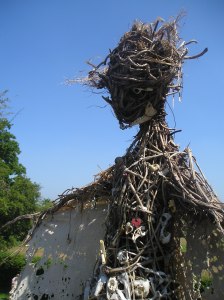The Hay-Man and the Scarecrow Princess
A princess danced in the middle of spring
in ragged white skirts with her heart on a string.
She had a sheep bone jaw and stones for eyes
a cornflower gown and a tiara of flies.
She had perched all winter through frost and thaw,
heard the song of the robin, the old crow’s caw,
dreaming of fox gloves, poppies and teasel,
a friend to the badger, the field mouse and weasel.
In bog beans and brambles a hay-man stood
as lonely as a beech tree away from the wood.
His heart cried out for the princess of straw
who he watched from the hill and loved her more.
Through summers of heartache, winters of grief,
they were divided by ditches, bracken and heath.
Fixed to the earth, staring up at the sky
friend of the birds, he wondered why,
they could not be together and dance in the wind
their rags flapping gently, even though they were pinned,
he wanted to know if she felt the same way
or if she was happy alone in the hay.
So he called for a swift who was quick through the air
and sent her a stitchwort to slip in her hair.
He waited ’till dusk for a gift in return
but nothing came back, no flower or fern.
So he spent the next day feeling sorry and flat
while a sparrow made its nest in his old top hat .
It left speckled eggs in his old jacket pocket
while his eye came loose in his old eye socket.
The princess meanwhile watched each setting sun
as the world slowly turned and she had begun
to wonder if ever a prince would see
her dance in the clover, and say, marry me.
For though she was not but a mile away
from the man on the hill, she faced the wrong way.
She could not look upon his scarecrow face
or see how he longed for her soft embrace.
Then one day the clouds turned black
a barn door blew open and then blew back.
The rain clattered down, on the rooftops it beat,
it splattered the mud and darkened the wheat.
But when the storm passed, it was then they found
the wind had blown the princess around.
As the sun crept out of its cloud hideaway
the scarecrow gazed upon his princess of hay.
Their love grew strong, that pearl of a summer,
and at every night’s end they danced for each other
and so all that was left, was one last thing:
she sent over at last her heart on a string.
But it was carried in the beak of a mean-hearted swallow
who dropped it down into a tree’s dark hollow.
The hay man waited for the heart to arrive
as a blood-red sun set in the blood-red sky.
Until at last he sent out his old friends the crows
who rescued the heart and dropped it down at his toes.
And the moment it fell there, a strange light shone,
a real man stood and the hay-man was gone.
He strolled down the hill, his shirt flapped in the breeze
and holding wild flowers, he went down on his knees
at the feet of the princess, now warm to the touch
and said, ‘do you love me’; she said ‘yes, very much.’
And so they married in a field of white flowers
in the eyes of the birds, in the cool evening hours.
A confetti of petals were dropped from the sky
then they slept in the poppies, the orchids and rye.




